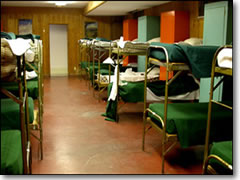How European hostels work
• hostels home
• how hostels work
• pros/cons
• finding hostels
• sleepsacks
• moneybelts
• packing list
 Grabbing a bed in a traditional hostel is a bit like staying at summer camp, only without the lanyards. These days, such rooms full of bunk-beds are being replaced with teensy "dorms" of just four to eight beds each.
Grabbing a bed in a traditional hostel is a bit like staying at summer camp, only without the lanyards. These days, such rooms full of bunk-beds are being replaced with teensy "dorms" of just four to eight beds each.
Grabbing a bed in a traditional hostel is a bit like staying at summer camp, only without the enforced crafts sessions involving lanyard keychains. These days, the gymnasiums crammed with bunk-beds are being replaced with teensy "dorms" of just four to eight beds each.
Here's how hostels work. You pay somewhere between €15 to €25 ($22–$38) and get a bunk in a dorm-like shared room. Depending on the hostel, there may be anywhere from 2 or 4 beds per room to as many as 100 beds in a vast space.
That said, over the past decade hostels have been trending toward smaller rooms (usually 4-6 beds per room). Most now feature a mix of smaller and larger rooms at differing prices: the fewer beds per room, the more you're going to pay for the (relative) privacy. Virtually all rooms are sex-segregated (in some older and more institutional hostels, the segregate by floor).
You will also be assigned a locker for your bags; use it. Ninety percent of your fellow cheerful backpackers are honest folk who wouldn't even stoop to opportunistic minor theft...but there's no telling when the other 10% might have a bunk in your room.
You always pay a per-person rate—which means it can be a savings for singles, but two or three people traveling together can usually find hotels for the same price or even less. On the other hand, hostels can be an excellent bet for families as there are loads of hostels with 4-bunk rooms offering semi-private housing.
Bathrooms are always shared—sometimes each dorm room has its own; usually its a giant bath down the hall shared by all dorms.
Breakfast is often included, and other cheap but lackluster meals are available.
To stay in some hostels, you must be a card-carrying member of Hostelling International (see "Finding Hostels")—or the card will at least get you a discount. However, I've found that
official HI-affiliated hostels tend to be the most depressingly institutionalized ones: school-marmy, rigid, bland, and boring enforcing far more stringent rules. Private hostels tend to be far more interesting, festive, salubrious, and fun. Also, they're far more likely to be located downtown (HI hostels are often on the outskirts).
Note I keep calling them simply "Hostels." The only ones that are still officially "youth" hostels are in Southern Germany, where the old under-26-only rule is still applied. Most hostels are now open as cheap digs for anyone of any age, and increasingly budget-minded families, adventurous folks in their forties, and even backpacking grandparents are availing themselves of this cheap-o option.



 ShareThis
ShareThis
This article was last updated in March 2008. All information was accurate at the time.
|
|
NoFrillsAir.com | BeyondHotels.net | EuropeTrains.org | EuropeHostels.org
About Us
Copyright © 2008
